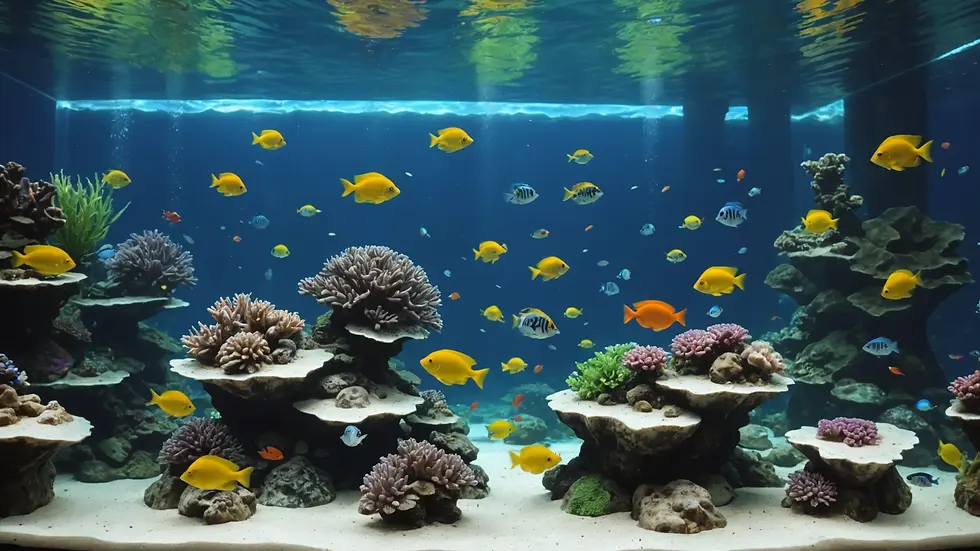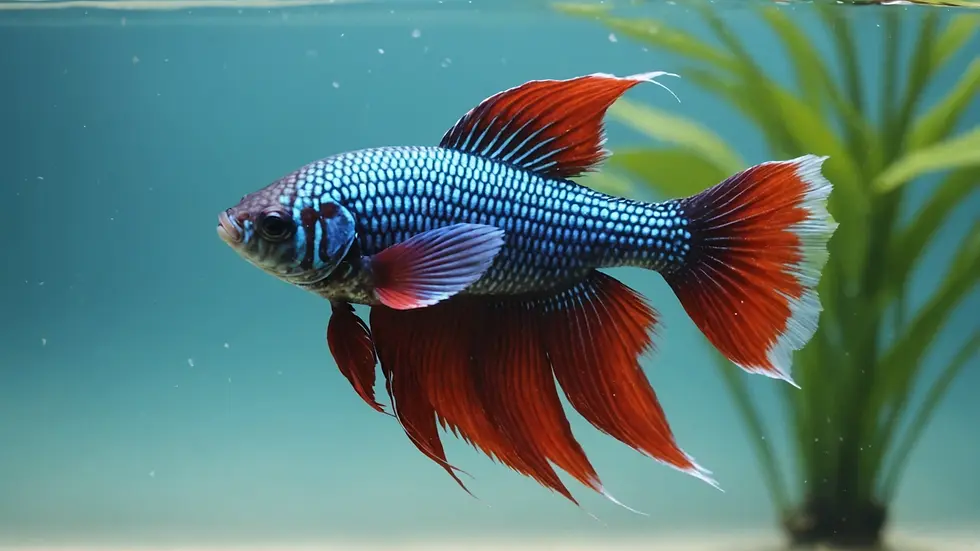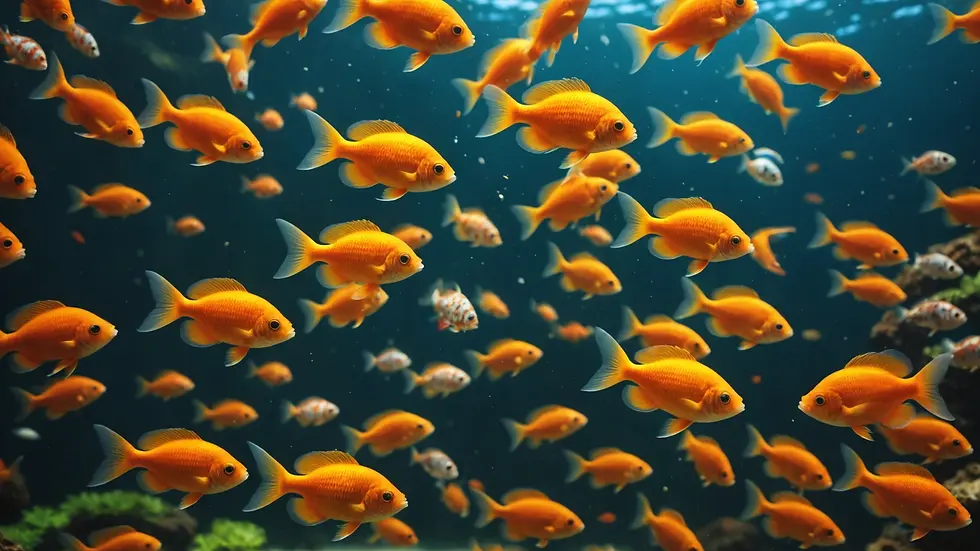How to Create a Customized Feeding Schedule for a Variety of Fish Species?
- Jyotiraj Borah
- Feb 7
- 5 min read
Creating a feeding schedule for different fish species is key to keeping them healthy and encouraging growth. Each species has specific dietary needs and feeding habits. Therefore, a universal approach simply won't work. In this guide, you'll learn how to create a tailored feeding schedule that meets the unique nutritional requirements of your fish and ensures they receive the right food at the right time.
Understanding Fish Dietary Needs
Fish have varying dietary requirements influenced by their species, size, age, and activity level. Some fish are plant eaters (herbivores), while others prefer meat (carnivores) or a mix (omnivores). Understanding these distinctions is the first step to crafting an effective feeding schedule.
Herbivorous fish need a diet high in plant matter. This includes algae, fresh greens, and specialized pellets. For example, species like Mollies thrive on spirulina flakes.
Carnivorous fish require food rich in protein, such as live or frozen foods like worms, brine shrimp, or small fish. For instance, Oscars flourish on a diet that includes frozen bloodworms.
Omnivores, like Guppies, can eat both plant and animal matter, which gives you flexibility. They can have a balanced diet containing both flakes and freeze-dried food.
A strong understanding of these dietary needs lays the groundwork for a successful feeding strategy.
The Importance of Fish Sizes and Ages
When creating a feeding schedule, it is vital to consider the size and age of your fish. Young fish generally have different nutritional requirements than adults. Juveniles may need more protein to support rapid growth, while adults require balanced meals with fewer feedings.
For example, a baby Betta fish needs frequent small meals with high protein, while an adult Betta thrives on just one to two feedings per day.
The size of the fish also affects food particle size. Small fish may struggle with larger pellets, while bigger fish require larger pieces to meet their energy needs.
Tailoring your feeding based on the size and age of your fish will lead to healthier fish and a more harmonious aquarium.
Feeding Schedules: Weekly vs. Daily
Feeding schedules can be structured either daily or weekly. Typically, a daily feeding schedule is better for fish that need regular meals, while a weekly schedule may work for certain species.
Daily Feeding Schedule
For fish that need daily sustenance, like tropical fish, a consistent routine is crucial. Here’s a sample daily feeding schedule:
Morning: Feed once after the aquarium lights turn on. Use high-protein options for carnivores and algae-based food for herbivores.
Afternoon: Offer a second light feeding. This mix of plant and animal-based options can cater to omnivores.
Evening: Scatter food around the tank to promote foraging. This not only mimics their natural feeding behavior but also minimizes aggression during meals.
Establishing a routine can help reduce stress among your fish.
Weekly Feeding Schedule
Some fish, especially those that fast or are less active, can function well on a weekly feeding schedule. This could look like:
Day 1: Feed a high-fat diet for carnivores, like high-fat pellets.
Day 3: Provide a variety of vegetable matter for herbivores, like blanched zucchini.
Day 5: Offer a protein-rich meal for omnivores, such as a mix of pellets and bloodworms.
Day 7: Conduct a water change and observe feeding habits to monitor health.
This schedule allows you to track fish health more effectively while ensuring they receive varied nutrition.
Tailoring Diet for Specific Fish Species
Now that you have a strategic foundation, let’s customize feeding schedules for various specific fish species.
Betta Fish
Betta fish are carnivorous and need a protein-rich diet. Follow this schedule:
Frequency: Feed 2-3 times a day.
Portion Size: Offer only what they can eat in 2-3 minutes to prevent overfeeding.
This approach will keep your Betta healthy and prevent issues like swim bladder disease.
Goldfish
Goldfish are omnivores. Their feeding routine can include:
Frequency: Feed 2-3 times a day.
Food Types: Use high-quality flakes, pellets, and fresh vegetables occasionally.
Important: Avoid overfeeding, as goldfish can be easily stressed by a bloated stomach.
Cichlids
Cichlids have different dietary habits depending on their species:
Frequency: Feed 2 times a day.
Diet: Provide a mixture of quality pellets, freeze-dried foods, and sometimes live food like brine shrimp.
Changing their diet based on species can aid in optimal growth.
Tetras
Tetras prefer smaller, frequent meals throughout the day:
Frequency: Feed 2-3 times per day.
Food Type: Use small pellets or flakes and treat them to bloodworms or daphnia occasionally.
As schooling fish, it's important to keep them in groups for a smoother feeding process and better overall health.
Customizing diets for each species will lead to healthier and more vibrant fish.
Observing Fish Behavior During Feedings
Pay attention to your fish's behavior during feedings. Their reactions can reveal a lot about their health and hunger level. Some fish will eagerly swim to the surface, while others may appear shy.
Signs of Overfeeding
Belly Bulging: Fish may look swollen.
Inactivity: They may swim sluggishly.
Uneaten Food: Leftover food in the tank indicates possible overfeeding.
Signs of Underfeeding
Aggression: Fish may fight for limited food.
Pale Coloration: A significant loss of color can indicate they are unhealthy.
Keep an eye on essential behaviors to adjust your feeding schedule. It ensures your fish stay healthy and active.
Adjusting the Schedule for Tank Size and Number of Fish
The size of your tank, along with the number of fish, greatly influences your feeding schedule. More fish means more competition for food, which may require adjustments to your routine.
Smaller Tanks
In smaller tanks, fish can quickly exhaust their food options. Here’s how to adapt:
Frequency: Increase the number of smaller meals throughout the day.
Food Distribution: Spread the food in various spots for easier access.
Larger Tanks
In larger tanks, maintain a consistent feeding schedule while adjusting portion sizes based on fish activity.
Frequency: Stick to your established schedule while monitoring how much food each fish consumes.
Observation: Pay attention to tank dynamics. You might find that active species need more feeding while slower ones require less.
Adjusting your feeding as needed will make for a more balanced tank environment.
The Role of Water Quality in Feeding
The quality of water in your aquarium influences your fish's health and feeding habits. Good water conditions can enhance appetite.
Maintaining Clean Water
Routine tank maintenance is crucial:
Regular Water Changes: Aim for a 10-15% change weekly, increasing frequency if tests show poor parameters.
Filtration Systems: Ensure your filter operates efficiently to keep the water clean.
Water Testing: Regularly check pH, ammonia, nitrites, and nitrates to maintain a balanced environment.
Healthy water conditions create an ideal setting for your fish to thrive and enjoy their meals.
Final Insights on Feeding Fish
Creating a tailored feeding schedule for different fish species is crucial for their health and contributes to a thriving aquarium community. By understanding dietary needs, sizes, ages, and behavior, you can develop a feeding strategy that suits each species in your tank.
Regular observation and flexibility will ensure your fish remain happy and vibrant. Always remember that a well-fed fish is a healthy fish, so enjoy watching them thrive in their aquatic homes.
By mastering your feeding schedule, you can cultivate a dynamic aquarium and promote the well-being of your aquatic pets.







Comments